Abstract
A total of 345 shipyard workers (aged 23 to 47) volunteered to perform progressive exercise on a cycle ergometer (15 W/min increments) up to the symptom limited maximum. The results were used to obtain maximal oxygen uptake (nO2 max), the oxygen uptake at a respiratory exchange ratio of unity (nO2 at R1.0), and cardiac frequency at an oxygen uptake of 45 mmol/min (fC45). In this group 156 men (45% of initial population) attained nO2 max as defined, 108 (31%) withdrew or did not exercise maximally, and 49 (14%) had transient electrocardiographic abnormalities. For the 156 men extrapolation of the relation of cardiac frequency on oxygen uptake to the predicted maximal cardiac frequency resulted in overestimation of nO2 max by 9.6%. nO2 Max per kg body mass was negatively correlated with body mass. nO2 Max (mean value 130.6 mmol/min) was described in terms of age, fat free mass, smoking (yes or no), and level of habitual activity (rated 1 to 4): the standard error of the estimate (SEE) was 17.3 mmol/min (R2 0.42); the equation was suitable for reference values. For estimating the nO2 max of individual men an empirical relation based on nO2 at R1.0, fC45, fat free mass, and % body fat had an SEE of 12.1 mmol/min (R2 0.67). Seventy six per cent of men (88% of those who exercised) attained nO2 at R1.0 (oxygen uptake approximately 73% of maximum). Thus the nO2 max could be estimated in a higher proportion of men than could achieve nO2 max. The estimate is appropriate for assessing exercise capacity in relation to employment.(ABSTRACT TRUNCATED AT 250 WORDS)
Full text
PDF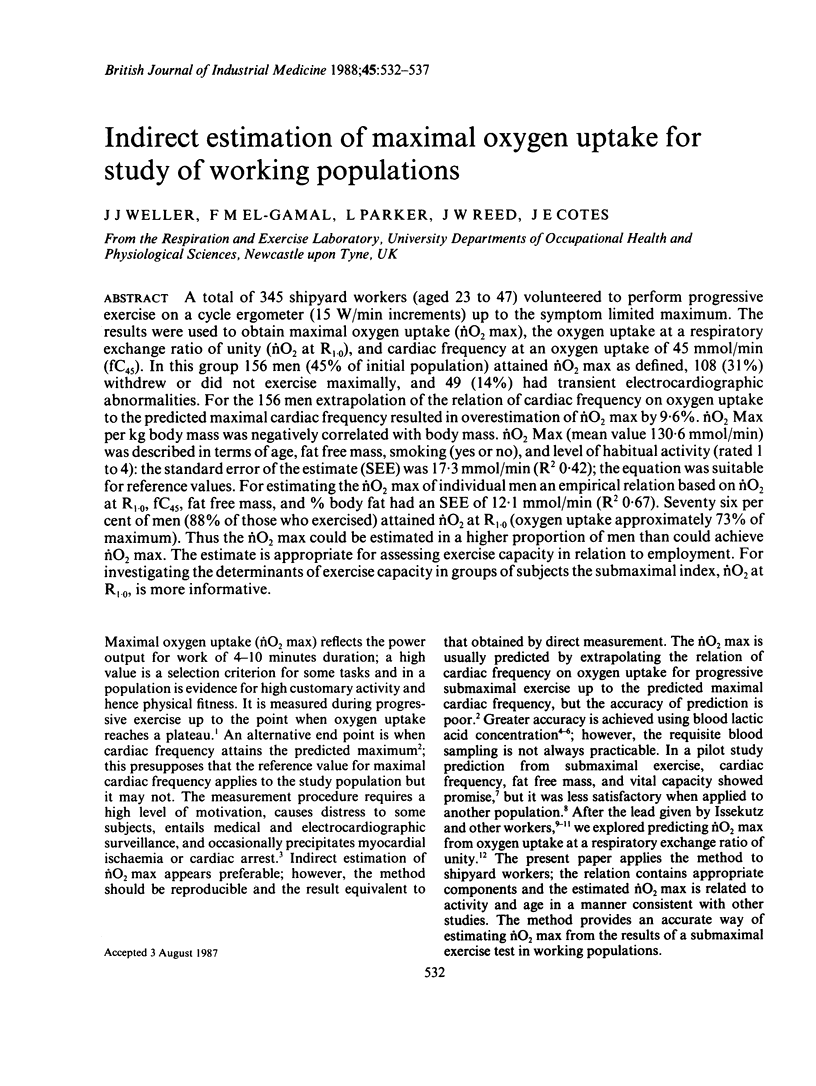
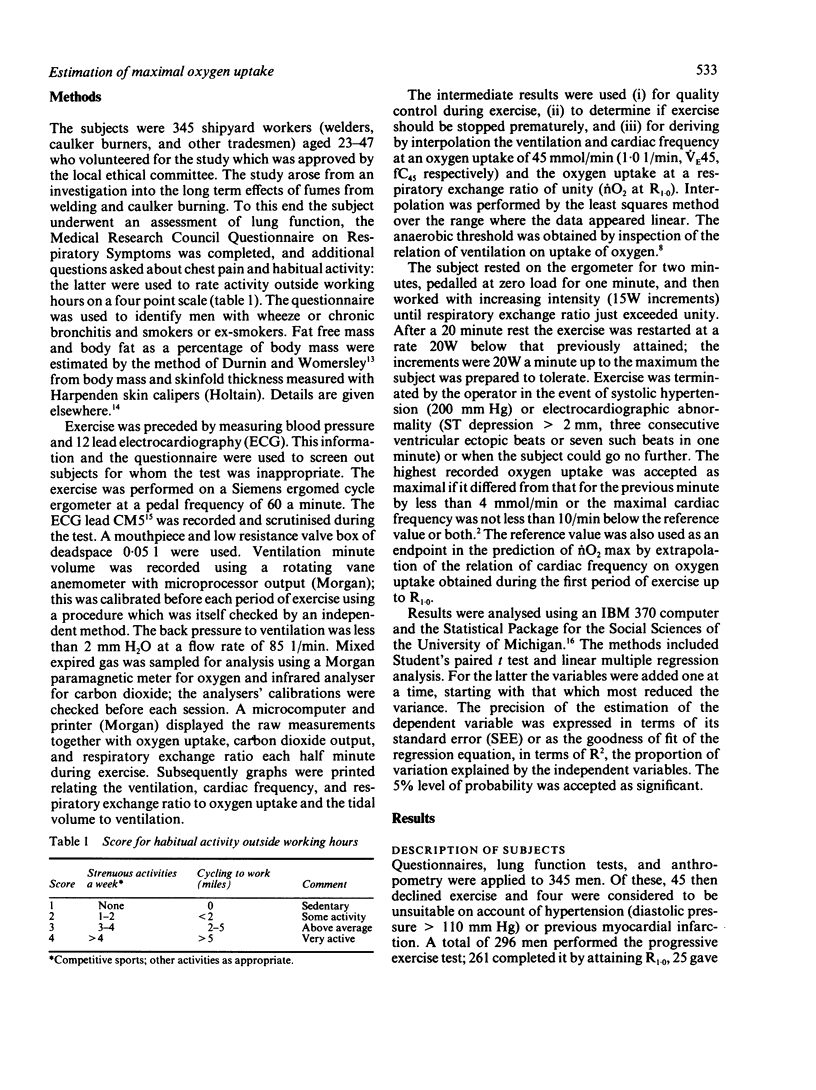
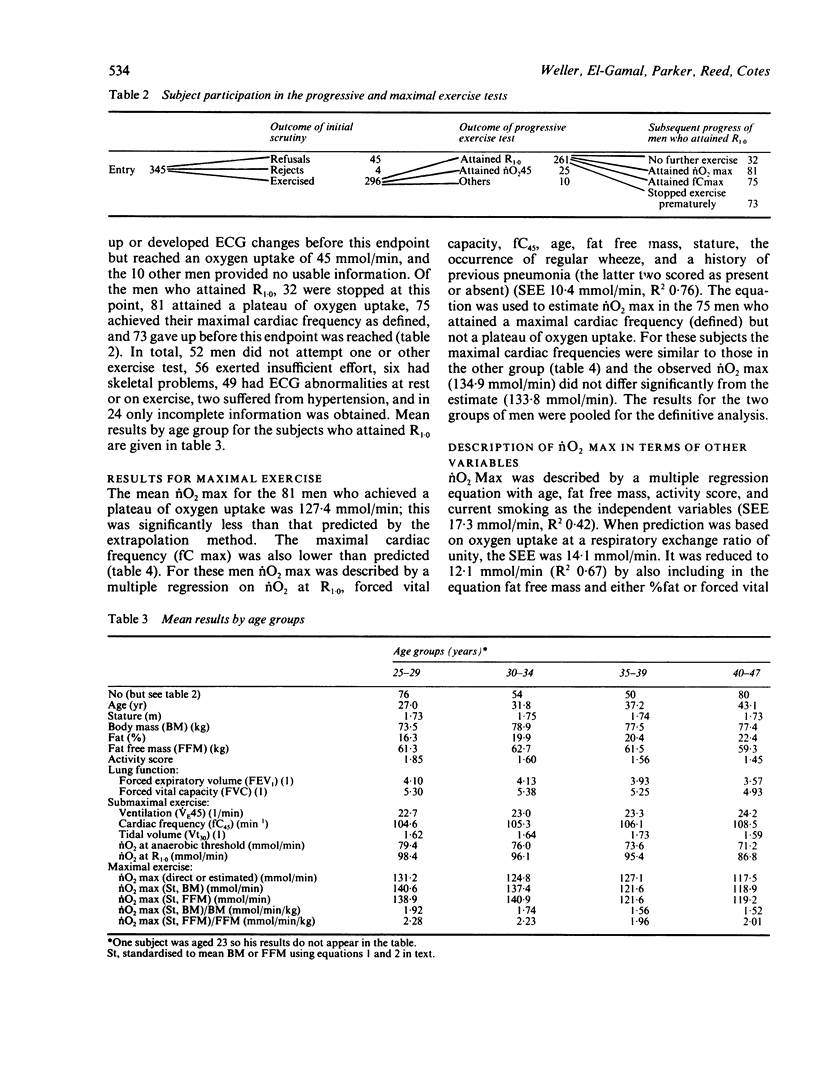
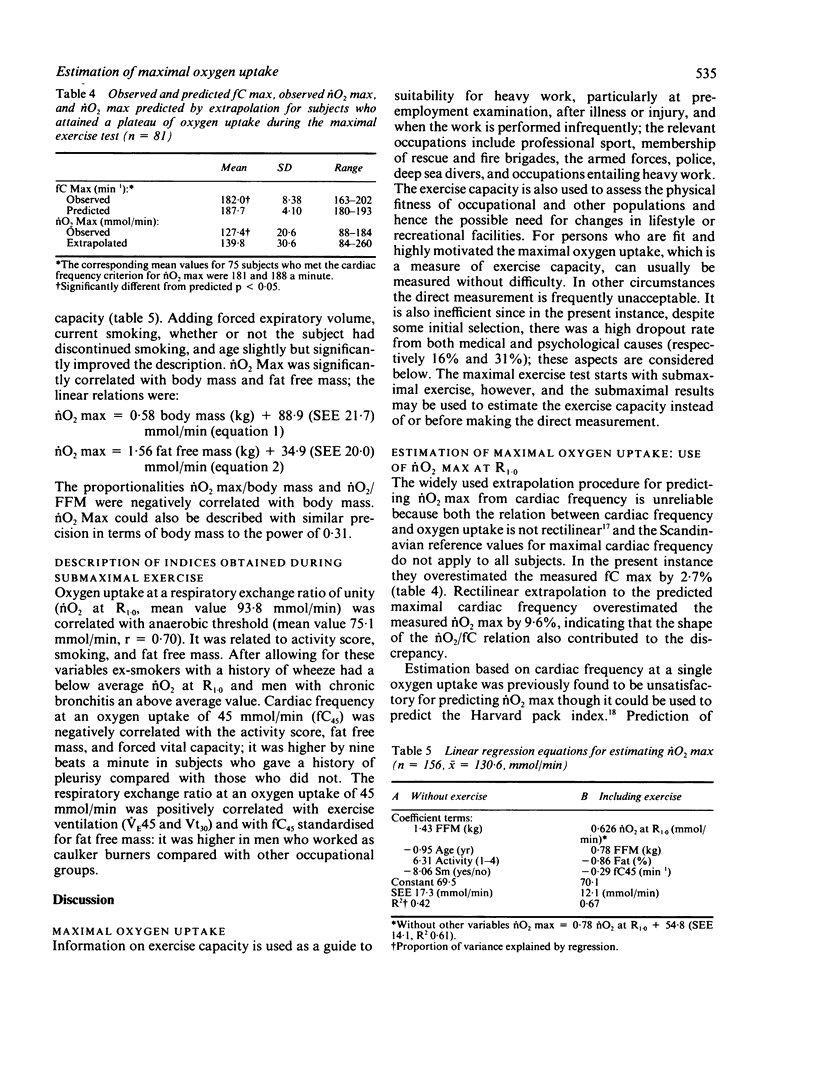
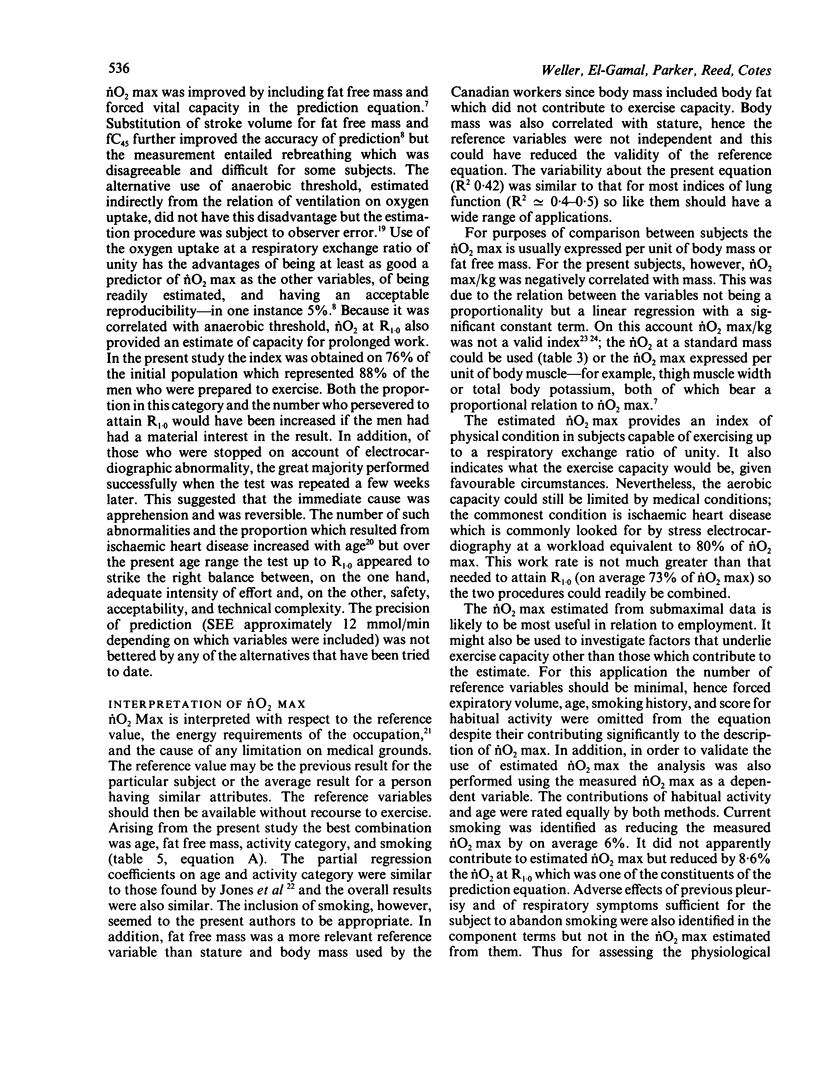
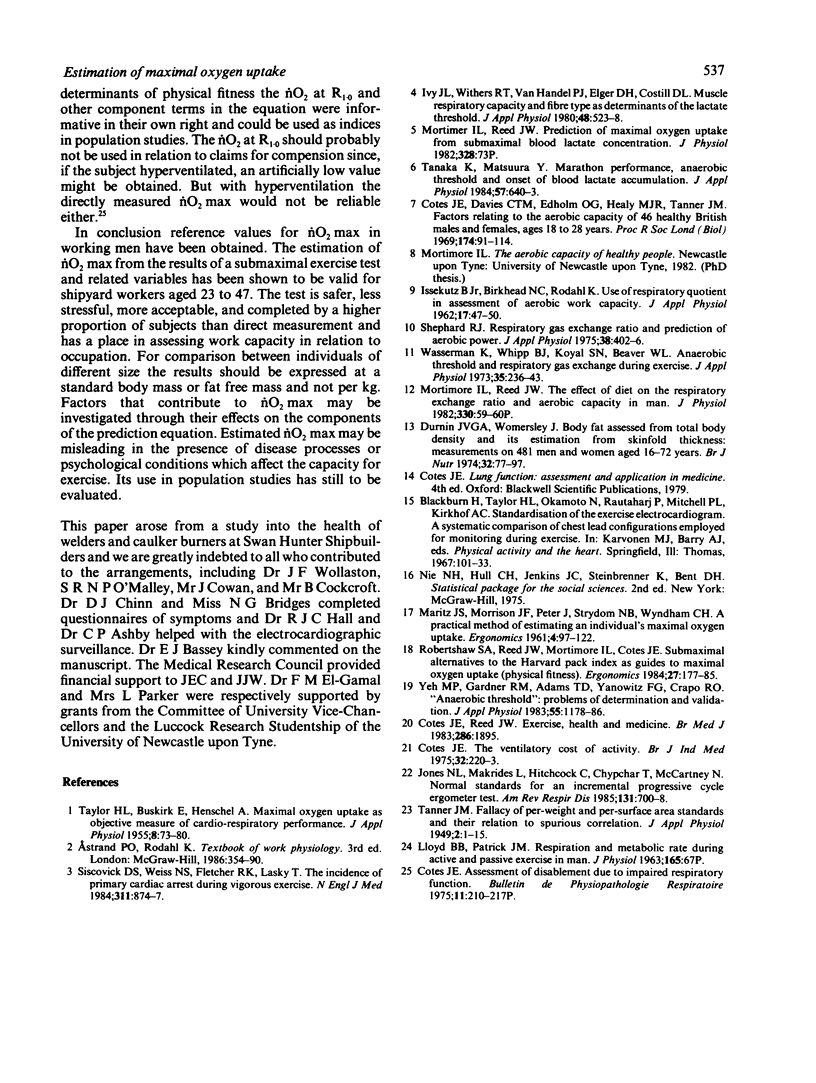
Selected References
These references are in PubMed. This may not be the complete list of references from this article.
- Baldissera F., Campadelli P., Piccinelli L. Neural encoding of input transients investigated by intracellular injection of ramp currents in cat alpha-motoneurones. J Physiol. 1982 Jul;328:73–86. doi: 10.1113/jphysiol.1982.sp014253. [DOI] [PMC free article] [PubMed] [Google Scholar]
- Berbenets V. F., Bobylev G. G., Guida I. L., Pevnitskii I. S., Rybnikov V. V. Universal'naia odnomestnaia meditsinskaia barokamera BL-3. Med Tekh. 1982 May-Jun;(3):59–60. [PubMed] [Google Scholar]
- Cotes J. E., Davies C. T., Edholm O. G., Healy M. J., Tanner J. M. Factors relating to the aerobic capacity of 46 healthy British males and females, ages 18 to 28 years. Proc R Soc Lond B Biol Sci. 1969 Oct 7;174(1034):91–114. doi: 10.1098/rspb.1969.0082. [DOI] [PubMed] [Google Scholar]
- Cotes J. E., Reed J. W. Exercise, health, and medicine. Br Med J (Clin Res Ed) 1983 Jun 11;286(6381):1895–1895. doi: 10.1136/bmj.286.6381.1895. [DOI] [PMC free article] [PubMed] [Google Scholar]
- Cotes J. E. The ventilatory cost of activity. Br J Ind Med. 1975 Aug;32(3):220–223. doi: 10.1136/oem.32.3.220. [DOI] [PMC free article] [PubMed] [Google Scholar]
- Durnin J. V., Womersley J. Body fat assessed from total body density and its estimation from skinfold thickness: measurements on 481 men and women aged from 16 to 72 years. Br J Nutr. 1974 Jul;32(1):77–97. doi: 10.1079/bjn19740060. [DOI] [PubMed] [Google Scholar]
- Ivy J. L., Withers R. T., Van Handel P. J., Elger D. H., Costill D. L. Muscle respiratory capacity and fiber type as determinants of the lactate threshold. J Appl Physiol Respir Environ Exerc Physiol. 1980 Mar;48(3):523–527. doi: 10.1152/jappl.1980.48.3.523. [DOI] [PubMed] [Google Scholar]
- Jones N. L., Makrides L., Hitchcock C., Chypchar T., McCartney N. Normal standards for an incremental progressive cycle ergometer test. Am Rev Respir Dis. 1985 May;131(5):700–708. doi: 10.1164/arrd.1985.131.5.700. [DOI] [PubMed] [Google Scholar]
- Robertshaw S. A., Reed J. W., Mortimore I. L., Cotes J. E., Afacan A. S., Grogan J. B. Submaximal alternatives to the Harvard pack index as guides to maximal oxygen uptake (physical fitness). Ergonomics. 1984 Feb;27(2):177–185. doi: 10.1080/00140138408963475. [DOI] [PubMed] [Google Scholar]
- Shephard R. J. Respiratory gas exchange ratio and prediction of aerobic power. J Appl Physiol. 1975 Mar;38(3):402–406. doi: 10.1152/jappl.1975.38.3.402. [DOI] [PubMed] [Google Scholar]
- Siscovick D. S., Weiss N. S., Fletcher R. H., Lasky T. The incidence of primary cardiac arrest during vigorous exercise. N Engl J Med. 1984 Oct 4;311(14):874–877. doi: 10.1056/NEJM198410043111402. [DOI] [PubMed] [Google Scholar]
- TAYLOR H. L., BUSKIRK E., HENSCHEL A. Maximal oxygen intake as an objective measure of cardio-respiratory performance. J Appl Physiol. 1955 Jul;8(1):73–80. doi: 10.1152/jappl.1955.8.1.73. [DOI] [PubMed] [Google Scholar]
- Tanaka K., Matsuura Y. Marathon performance, anaerobic threshold, and onset of blood lactate accumulation. J Appl Physiol Respir Environ Exerc Physiol. 1984 Sep;57(3):640–643. doi: 10.1152/jappl.1984.57.3.640. [DOI] [PubMed] [Google Scholar]
- Wasserman K., Whipp B. J., Koyl S. N., Beaver W. L. Anaerobic threshold and respiratory gas exchange during exercise. J Appl Physiol. 1973 Aug;35(2):236–243. doi: 10.1152/jappl.1973.35.2.236. [DOI] [PubMed] [Google Scholar]
- Yeh M. P., Gardner R. M., Adams T. D., Yanowitz F. G., Crapo R. O. "Anaerobic threshold": problems of determination and validation. J Appl Physiol Respir Environ Exerc Physiol. 1983 Oct;55(4):1178–1186. doi: 10.1152/jappl.1983.55.4.1178. [DOI] [PubMed] [Google Scholar]


